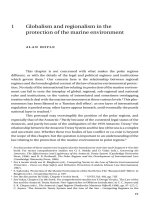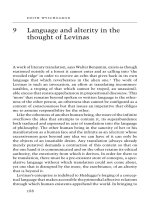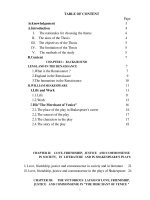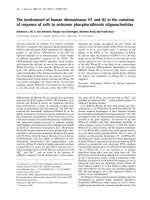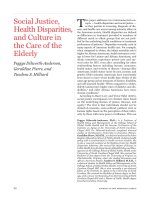Fabulous science fact and fiction in the history of scientific discovery
Bạn đang xem bản rút gọn của tài liệu. Xem và tải ngay bản đầy đủ của tài liệu tại đây (2.61 MB, 320 trang )
Fabulous science
Fabulous science
Fact and fiction in the history of scientific discovery
John Waller
1
1
Great Clarendon Street, Oxford OX2 6DP
Oxford University Press is a department of the University of Oxford.
It furthers the University’s objective of excellence in research, scholarship,
and education by publishing worldwide in
Oxford New York
Auckland Bangkok Buenos Aires Cape Town Chennai
Dar es Salaam Delhi Hong Kong Istanbul Karachi Kolkata
Kuala Lumpur Madrid Melbourne Mexico City Mumbai Nairobi
São Paulo Shanghai Taipei Tokyo Toronto
and an associated company in Berlin
Oxford is a registered trade mark of Oxford University Press
in the UK and in certain other countries
Published in the United States
by Oxford University Press Inc., New York
© John Waller 2002
The moral rights of the authors have been asserted
Database right Oxford University Press (maker)
First published 2002
All rights reserved. No part of this publication may be reproduced,
stored in a retrieval system, or transmitted, in any form or by any means,
without the prior permission in writing of Oxford University Press,
or as expressly permitted by law, or under terms agreed with the appropriate
reprographics rights organization. Enquiries concerning reproduction
outside the scope of the above should be sent to the Rights Department,
Oxford University Press, at the address above
You must not circulate this book in any other binding or cover
and you must impose this same condition on any acquirer
British Library Cataloguing in Publication Data
Data available
Library of Congress Cataloging in Publication Data
Data available
ISBN 0‒19‒280404‒9
1 3 5 7 9 10 8 6 4 2
Typeset by Footnote Graphics, Warminster, Wilts
Printed in Great Britain
on acid-free paper by
T.J. International Limited
Padstow, Cornwall
To my parents, with all my love
Contents
List of illustrations
Acknowledgements
viii
xi
Introduction: What is history for?
Part 1: Right for the wrong reasons
1
10
1 The pasteurization of spontaneous generation
14
2 ‘The battle over the electron’
22
3 The eclipse of Isaac Newton: Arthur Eddington’s
‘proof’ of general relativity
48
4 Very unscientific management
64
5 The Hawthorne studies: finding what you are
looking for
78
Conclusion to Part 1: Sins against science?
99
Part 2: Telling science as it was
108
6 Myth in the time of cholera
114
7 ‘The Priest who held the key’: Gregor Mendel
and the ratios of fact and fiction
132
8 Was Joseph Lister Mr Clean?
160
9 The Origin of Species by means of use-inheritance
176
10 ‘A is for ape, B is for Bible’: science, religion, and
melodrama
204
11 Painting yourself into a corner: Charles Best and
the discovery of insulin
222
12 Alexander Fleming’s dirty dishes
246
13 ‘A decoy of Satan’
268
Conclusion to Part 2: Sins against history?
284
Notes on sources
Index
296
302
vii
illustrations
The ‘dauntless three’ guard the bridge over the Tiber. (Engraving by George
Scharf Jr, from Thomas Babington Macaulay’s Lays of Ancient Rome, London,
1867.)
xii
Louis Pasteur (1822–95) in his laboratory. (Engraving after Paul Edelfelt’s 1885
painting, courtesy of the Wellcome History of Medicine Library.)
14
Pasteur’s famous swan-necked flasks. (From Oeuvres de Pasteur, Vol. 2, Paris,
1922.)
21
Robert A. Millikan (1868–1953). (The Archives, California Institute of
Technology.)
32
Millikan’s oil-drop experimental apparatus. (The Archives, California Institute
of Technology.)
38
Sir Arthur Stanley Eddington (1882–1944). (Royal Astronomical Society.)
48
Frederick Winslow Taylor (1856–1915). (Photograph courtesy of the F. W.
Taylor Collections, S. C. Williams Library, Stevens Institute of Technology.)
64
Fritz J. Roethlisberger (1898–1974). (Photograph courtesy of the Historical
Collections Department, Baker Library, Harvard Business School.)
78
John Snow (1813–58). (Photograph courtesy of The Wellcome Trust Library.)
114
Detail of John Snow’s spot map of the Broad Street Pump area. (From a map in
Snow’s On the Mode and Communication of Cholera, London, 1855.)
118
Gregor Mendel (1823–84). (Photogravure courtesy of The Wellcome Trust
Library.)
132
139
A typical Punnet Square.
Joseph Lister, first Baron Lister of Lyme Regis (1827–1912). (By Barraud’s Ltd,
courtesy of The Wellcome Trust Library.)
160
An operation using Lister’s carbolic-acid spray. (Engraving from William Watson
Cheyne’s Antiseptic Surgery: Its Principles, Practice, History, and Results, London,
1882.)
170
Charles Darwin (1809–82). (Photograph by his son Leonard Darwin, courtesy of
The Wellcome Trust Library.)
176
William Thomson, first Baron Kelvin of Largs (1824–1907). (Lithograph by
T. H. Maguire, 1849, courtesy of The Wellcome Trust Library.)
199
viii
list of illustrations
Thomas H. Huxley (1825–95) lecturing on the gorilla. (Photograph by Cundall,
Downes & Co. of London, courtesy of The Wellcome Trust Library.) Samuel
Wilberforce (1805–73), Bishop of Oxford. (Photograph by Julia Margaret
Cameron, courtesy of The Wellcome Trust Library.)
204
Charles Herbert Best (1899–1978). (Photograph courtesy of The Wellcome Trust
Library.)
222
Frederick Banting (1891–1941) in his laboratory. (Photograph courtesy of The
Wellcome Trust Library.)
227
Alexander Fleming (1881–1955) examining a Petri dish. (Alexander Fleming
Laboratory Museum, St Mary’s NHS Trust.)
246
Sir James Young Simpson (1811–70). (Wood engraving, courtesy of The
Wellcome Trust Library.)
268
ix
Acknowledgements
ach chapter in this book draws heavily on the original scholarship
of leading historians of science. The scholarly papers I consulted
are the results of thousands of hours of laborious research, conducted by historians who often began their investigations confident of the
veracity of the myths they would later explode. To pay these researchers
their due, and to suggest where the reader may go to read further, I have
included a brief statement on my sources at the end of the volume. In
many instances I have added my own analysis and commentary, so any
resulting errors or infelicities must of necessity be my responsibility alone.
This book is also indebted to the scholars who have stimulated my
fascination for the discipline of history from school through university:
Thomas Eason, Jeffrey Grenfell-Hill, Simon Skinner, Maurice Keen, the
late Michael Mahoney, Joe Cain, Janet Browne, and Everett Mendelsohn
in particular. The students who I have helped instruct at Oxford, London,
and Harvard universities inspired me to bring these stories to a wider
audience. And the staffs of Imperial College London’s Centre for the
History of Science, Technology and Medicine and London’s Wellcome
Trust Centre for the History of Medicine drew my attention to much
of the scholarship upon which this book is based. The archival staffs of the
Wellcome Library for the History and Understanding of Medicine,
Harvard’s Baker Business Library and Countway Medical Library, the
Alexander Fleming Laboratory Museum at St Mary’s Hospital, the Royal
Astronomical Society, and the California Institute of Technology very
kindly allowed me to reproduce photographic images.
I am also profoundly grateful to Richard and Penny Graham-Yooll,
Adam Hedgecoe, Darian and Alison Stibbe, Jon Turney, and Jane,
Michael, and Susan Waller for their excellent editorial advice and encouragement. My father, Michael Waller, has been a wonderful source of
inspiration, illumination, and guidance. Michael Rodgers and Abbie
Headon at Oxford University Press and copyeditor Sarah Bunney have
also been most helpful. Finally I would like to thank my wife, Abigail, for
her unstinting affection and support.
John Waller, December 2001
E
xi
part title
xii
chapter title
Introduction | What is history for?
1
What is history for?
Remark all these roughnesses, pimples, warts, and everything
as you see me, otherwise I will never pay a farthing for it.
Oliver Cromwell’s instruction to Lely
on the painting of his portrait.
he great biologist Louis Pasteur suppressed ‘awkward’ data because
it didn’t support the case he was making. Gregor Mendel, the
supposed ‘founder of genetics’, was no Mendelian. Joseph Lister’s
famously clean hospital wards were actually notoriously dirty. Alexander
Fleming misled the world about his role in the discovery of penicillin.
And Einstein’s general relativity was only ‘confirmed’ in 1919 because an
eminent British scientist ruthlessly massaged his figures.
These are some of the recent findings of historians covered in this
book. In writing it my primary aim has been to bring to the attention of
a wider audience the fruits of a generation’s research into the history of
science. But, although the scholarship I draw on seriously challenges the
reputations of major scientific figures, this is not an exercise in pointless
iconoclasm. Above all, this book aims to offer insights into the conduct of
scientific debate, the securing of scientific immortality, and the complex
interplay between scientists and the worlds in which they operate.
In highlighting these ‘warts and all’ studies, I am firmly positioning
myself on one side of a great historical divide. As the divide in question
runs through the entire historical enterprise, I can illustrate it with an
example taken from Classical Rome. These are the opening lines from
‘Horatius’, the first in Thomas Babington Macaulay’s epic series of
poems, Lays of Ancient Rome, written in 1842:
T
Lars Porsena of Clusium
By the Nine Gods he swore
That the great house of Tarquin
Should suffer wrong no more.
By the Nine Gods he swore it,
And named a trysting day,
Previous page: The ‘dauntless three’ guard the bridge over the Tiber, from Macaulay’s epic
poem Lays of Ancient Rome.
what is history for?
And bade his messengers ride forth,
East and west and south and north,
To summon his array.
A favourite of the Victorian schoolroom, this poem still has the
power to quicken the pulse and enthuse the reader with martial pride.
What seems to make the Lays of Ancient Rome doubly stirring is its historical veracity. Macaulay drew his great poem not from his admittedly fertile
imagination, but from the Roman histories themselves. These tell how
in the sixth century BC the enemies of Rome led by the Etruscan Lars
Porsena had fought, sacked, and plundered their way to the shores of
the Tiber. At last, their greatest prize—the eternal city itself—lay all
but defenceless before them. The battle-hardened troops of a long and
glorious campaign gazed across to a city facing slaughter, rapine, and ruin.
But a quick-thinking Roman Consul had seen a way to save his people.
The plan was simple. The only bridge over the Tiber was barely wide
enough for one man to pass at a time. So a handful of men could hold the
bridge long enough for it to be cut away behind them. As these valiant
soldiers plunged to a watery death, they would have the consolation of
fulfilling every Roman matron’s deepest desire for her son: his giving his
life to save the Nation. This notwithstanding, so tough was the challenge
that at first only brave Horatio accepted it. Then two others followed his
example.
It was this ‘dauntless three’ that confronted the Etruscan host as it
approached the bridge. As the Consul had foreseen, the narrowness of the
structure meant that one-to-one fighting was all that was practical. The
odds thus reduced, Horatio and his colleagues slew the ablest champions
Lars Porsena could throw at them. As the bridge started to fall, Horatio’s
two companions made it back to shore as he covered their retreat. For him
there was no escape. Valiantly out in front, he could do nothing except
prepare to meet his end. Exhausted, wounded, and weighed down with
armour, Horatio plunged beneath the surface of the Tiber. A stunned
calm fell upon Rome and her enemies:
No sound of joy or sorrow
Was heard from either bank;
But friends and foes in dumb surprise,
With parted lips and straining eyes,
3
introduction
Stood gazing where he sank;
And when above the surges,
They saw his crest appear,
All Rome sent forth a rapturous cry,
And even the ranks of Tuscany
Could scarce forbear to cheer.
Horatio lives! Swimming back to the Roman shore, his feat of daring
and courage momentarily united the warring sides in admiration and awe.
Who knows how long it was before the invaders’ sentimental feelings
gave way to bitterness? But what is clear is that Horatio’s courage saved
Rome. In recognition of this, his fellow citizens lavished tributes and
prizes on him. Then, again according to Macaulay, to immortalize the
event, ‘they made a molten image, / And set it up on high, / And there it
stands unto this day / To witness if I lie.’
Look around the ruins of Rome today, however, and you will search
in vain for the statue of Horatio. Of course, given the amount of destruction that has occurred there, this does not necessarily give the lie to the
story. But it is well and truly laid to rest by the detailed and reliable chronicles of the sixth century BC, which describe how the Etruscan armies
swept irresistibly upon Rome and overwhelmed it. Within hours, those
inhabitants of Rome who survived the onslaught would have been forming the long, miserable columns typical of refugees in flight. These chronicles also show that the only laurels earned during the campaign decorated
the brow of Rome’s most implacable enemy, Lars Porsena. Of Horatio,
there is nothing. Rome’s humiliation, it is clear, was sudden, swift, and far
from painless.
So how did this fairy tale manage to get airborne? Partly because by
the time the Horatio myth took hold Rome had become the world’s
mightiest empire and she needed to invent a past of sufficient grandeur to
justify and glorify her present. The myth of Horatio did nicely because it
seemed to show that the Romans had always been great warriors, brave
fighters, and brimming with guile. But the popularity of the Horatio story
goes even deeper than this. By the first century AD the Romans were too
proud and too intoxicated by their new wealth and power to be capable of
believing that Lars Porsena had sacked Rome. In this heady atmosphere,
myth became established fact. The Horatio story, in other words, reflects
4
what is history for?
not history, but how a later generation of Romans needed to see their
forebears.
Robert Graves’s I, Claudius includes a wonderful scene in which the
Roman historians Livy and Pollio use the Horatio story to debate precisely the two rival approaches to history I am trying to illustrate. Their
exchange is unintentionally brought about by the stammering young
Claudius. Having warmly praised Livy’s style, he goes on to say that he
is somewhat puzzled by inconsistencies between Livy’s version of the
Etruscan War and evidence he has unearthed that, in fact, Rome was
defeated. Although Livy seeks to dismiss the counter-evidence as mere
propaganda, he soon makes clear that in his opinion the role of history is
not the uncovering of the Truth. Instead, it is that of arresting moral
decline by providing idealized role models to the young and of dignifying
the present through association with a glorious past. In contrast, Pollio
secures Claudius’s support for the rival view that the historian’s ultimate
duty is to the Truth.
There can be no doubt at all that, until very recently, Livy’s view
of history triumphed over Pollio’s as convincingly as did Lars Porsena
over the Romans. About 1700 years after Livy’s death, Macaulay happily
recycled Livy’s Ab Urbe Condita I as the Lays of Ancient Rome. The imperial
power had changed, but the inspirational objectives remained the same.
Among subsequent generations of classical historians (albeit posthumously), however, Macaulay met his Pollio. Wonderful though it is as a
poem, the story told in the Lays of Ancient Rome is now firmly consigned
to history’s dustbin. Nor is it alone. Acutely conscious of the human predilection to glamorize, embellish, and invent, historians over the past
hundred years have turned the same penetrating and unromantic gaze on
all fields of human endeavour. Pollio’s view of the proper role of history is
now in the ascendant.
But establishing precisely where the truth lies is rarely easy. Personal
biases of which the researcher may be unaware, a lack of unambiguous
data, and the difficulty of seeing the world as our ancestors saw it can
sometimes combine to make the task virtually impossible. Yet a neoimperialist in search of a modern Livy would be hard-pressed to find any
professional historian still comfortably working in this tradition. If ‘professional’ in the phrase ‘professional historian’ means anything, it means
5
introduction
an unambiguous commitment to seeking out the truth. Execution may
not always match aspiration, but that does not significantly diminish the
scale of the change that has taken place. To anyone who resents the loss of
his or her particular Horatio there is but one answer. Now, at least, you
are being told what can best be assayed as the truth.
Telling science as it is
When first thought about, it might seem that science is a field in which
propaganda of the type favoured by Livy would have little or no scope.
After all, science itself is all about the search for truth and the adversarial
nature of the scientific method should work relentlessly to ensure that
only valid ideas supported by well-designed experiments survive. I think
that after reading this book, the most likely response to such notions will
be ‘but that they were so’. Because they have been sought out to demonstrate the gap that can exist between myth and reality, the various case
studies I include are not offered as representative of all science or all
scientists. But one general message of the utmost importance can be drawn
from them. Even in the realms of science, take nothing at face value.
Until recent decades, the history of science was largely written by
those who wished to place their chosen subject in as favourable a light as
possible. Their motivations were various. Sometimes they worked at the
behest of individual scientists who wanted to make sure that their part in
the great drama of discovery did not go unsung. In other cases, the key
requirement was a good story. More laudably generations of teachers of
scientific subjects have wanted heroes for much the same reason that Livy
gave the Romans Horatio: to inspire by example. The chosen ones
entered the Pantheon of scientific heroes. Great laboratories and institutes
were named in their honour; each new generation of students was given
accounts of their travails and ultimate triumphs; and assorted statuary
serves as a perpetual memorial to their greatness.
In the last few decades, however, this approach has been rightfully
impugned. A new generation of scholars has shown that in many cases
what actually happened simply cannot sustain the enormous edifice subsequently built on it. Many of the great luminaries of the past were neither
as heroic nor selfless as has been supposed. Seemingly crucial experiments
6
what is history for?
are sometimes found to have been fatally flawed; results were often modified to suit the case being argued; and many were happy to use political
influence to advance their cause. Indeed, ample evidence is now available
to show that scientific merit is only one of many factors influencing the
acceptance of new ideas. Many pre-eminent scientific heroes fell far short
of proving the theories for which they are now famous. Men such as
Louis Pasteur, Joseph Lister, and Alexander Fleming were neither as surefooted nor as scrupulous as they are now thought to have been. Charles
Darwin was right at least partly for the wrong reasons. Others, such as
Gregor Mendel, have had greatness thrust on them by a highly manipulative posterity. And, not infrequently, individuals now cast as scientific
villains prove on closer examination to have been able scientists who just
happened, often for very good reasons, to have backed the wrong horse.
Above all, what this new research shows is that the conduct of
scientific enquiry is often a lot more haphazard than we tend to think.
Although the eventual outcome of a research programme may be a
fabulously rich collection of well-attested and highly predictive ideas, the
route to this happy state is often far more convoluted than subsequent
accounts will allow. Revealing what actually happened in some very
high-profile cases may help bring our conception of the scientific enterprise into much closer alignment with the actuality. None of this undercuts the status I believe modern science deservedly enjoys as the best way
of increasing our understanding of the physical world. But our expectations will be more realistically grounded if we come to appreciate that
science is as subject to extraneous influences—including the human
ego—as is any other field of human endeavour, past or present.
There is another important service that historians of science can
render. As in all other branches of history, ‘great man’ approaches
massively underplay the contributions made by the myriad individuals
who did not achieve this honoured status. Thousands upon thousands of
now largely forgotten researchers have contributed to scientific progress.
And with very few exceptions, great men or women are cumulatively far
less important than these forgotten legions of unsung heroes about whom
little is popularly known. Indeed, some mute inglorious scientists were
just as insightful and technically ingenious as those whose names have
lived on. In many such cases, the differences in historical treatment are
7
introduction
best explained in terms of a general preference for attaching major ideas
to a limited number of names, coupled with skills, or the want of them,
in the arts of self-promotion. The pristine hero, exemplified by brave
Horatio, is all too often an elaborate fiction. If we go back and look at the
primary sources, few reputations escape entirely unscathed.
In the context of these broader considerations, I have tried to use
these case studies of nineteenth- and twentieth-century science to make
three basic points. First, that we need to treat received accounts of scientific genius with the utmost circumspection. Thus we will find that Louis
Pasteur,Charles Darwin, Gregor Mendel, Thomas Huxley, Joseph Lister,
John Snow, Alexander Fleming, Frederick Winslow Taylor, James Young
Simpson, Charles Best, Arthur Eddington, the Nobel Prize-winning
Robert Millikan, and the authors of the famous ‘Hawthorne Study’ (Fritz
J. Roethlisberger and William J. Dickson) have all been squeezed, or have
squeezed themselves, into romantic schemas strongly redolent of the
Horatio myth. In many cases, these men were competing for laurels in a
highly competitive world in which the Queensbury rules of the scientific
method were routinely dropped in favour of the more-permissive code of
bare-knuckle fighting. The chapters I have devoted to Pasteur, Lister,
Taylor, Millikan, Eddington, Best, and Roethlisberger and Dickson illustrate this particularly strongly. Indubitably, each of these scientific greats
carried their share of human frailties.
The second point I seek to make is the critical importance of contextualization. Science is about much more than disembodied ideas. In
each chapter I set the events described in the broader context essential to a
full appreciation of the complexities involved in the process of scientific
discovery. This book stresses the role of the prevailing scientific paradigm, the social and political context, and the vagaries of chance, all of
which powerfully influence the rate and direction of scientific progress.
Traditional approaches rarely accorded such factors their full weight. My
hope is that these cases will demonstrate the critical importance of remedying this.
This allusion to context brings me to the final theme of the book.
Failure to take full account of context leads to an error that modern
historians call ‘presentism’. Individual chapters dealing with Lister, Mendel,
Darwin, Snow, Huxley, Simpson, and Fleming serve to elucidate this
8
what is history for?
problem. A vague affinity between a currently accepted theory and a
much earlier set of ideas is often enough to elevate the ancestor into the
Pantheon of scientific heroes. Just as Macaulay, Margaret Thatcher, and
very many others, have mistakenly read Magna Carta as an early flowering of English democratic values, those recounting the history of science
have often wrenched older ideas entirely out of context and interpreted
them as brilliant anticipations of modern knowledge.
Some of the greatest icons of science have acquired hero status in precisely this way. Put back into the context in which the originators lived
out their lives, many ideas are found to be much less clearly aligned with
what we now believe to be true. But we are taught to demand much of
our founding fathers. Their having been there at the beginning, pointing
the way forward, does not seem to be enough. There is also a tendency to
expect them, long after they have entered the grave, to remain in the van
of progress, their ideas at least broadly anticipating each new development. What we need to bear in mind is that the past really is another
country and most certainly not one of which the present was an inevitable
culmination. Therefore my third aim is to encourage contextualization
not only in its own right but also as a sovereign remedy to presentism. We
need to be committed to understanding the past on its own terms without
any reference to ‘what happened next’.
My final hope is that the cases I have chosen will prove fascinating in
themselves as powerful human dramas in which naked ambition has at
least as big a role as technical virtuosity. As such I am confident that they
will prove particularly appealing to the group who it has been suggested
are most willing to look at the world from the anti-presentist perspective:
those who have a strong spirit of adventure coupled with a deep respect
for the human intellect. To such minds, teasing out truth from fiction
serves only to enrich their understanding of the human condition.
9
Part one | Right for the wrong reasons
Louis Pasteur
Robert Millikan
Arthur Eddington
Frederick Winslow Taylor
Fritz J. Roethlisberger and William J. Dickson
he first five chapters share one common theme: each of the six
major scientists examined manipulated their experimental data to
fit their preconceived notions of how things really are. Then, to
win the scientific battles in which they were engaged, they exploited (to
varying degrees) their powers of obfuscation and deception, their friends
in high places, and their reputations as reliable witnesses. All six have been
fortunate in the fact that because they were advancing major ideas that
now enjoy, at the very least, widespread support, posterity has been largely
blind to the equivocal nature of the evidence they presented.
It would be unfortunate, however, were the next five chapters read as
attacks on the scientific enterprise. Naturally showing how scientific
debates can be distorted by historical context and the human ego does
detract from science’s reputation for unalloyed objectivity. Likewise,
there is no avoiding the conclusion that some of the greats of the history
of science sometimes let ambition get in the way of integrity and good
science. But the six scientists I examine in the following chapters are not
necessarily representative of science in general. I have selected them
because of the gulf that separates the myths surrounding their names from
the actuality. How much light they shed on scientific endeavour as a
whole will be considered in the Conclusion to Part 1.
With respect to Pasteur, Millikan, and Eddington, at this stage I should
like to make one further observation. The twentieth-century philosopher
of science Karl Popper made a useful distinction between discovery and
verification in the development of scientific knowledge. A committed and
eloquent believer in the ability of scientists to make sense of the world, he
nonetheless saw that the discovery stage may be much less rigorous and
disciplined than the point at which other scientists become involved and
T
12
right for the wrong reasons
begin the process of verification by trying to ‘falsify’ the original
researcher’s ideas. ‘The question how it happens that a new idea occurs
to a man—whether it is a musical theme, or a dramatic conflict, or a scientific theory—may be of great interest to empirical psychology; but it is
irrelevant to the logical analysis of scientific knowledge’ is how Popper
put it in 1959. Science only becomes reliable knowledge, he argued, after
its validity has been extensively tested over the course of many years.
Indeed, he was ‘inclined to think that scientific discovery is impossible
without faith in ideas which are of a purely speculative kind, and sometimes even quite hazy’.
This is the context in which the cases looked at in Part 1 need to be
understood. The initial evidence presented by these scientists was seriously
flawed and they were each led more by conviction than empirical data.
But had they been unequivocally wrong about the way in which the
world operates, then research by other scientists in other laboratories
would soon have shown this to be the case. Incorrect but plausible ideas
have often been endorsed by sections of the modern scientific community.
Almost never, however, have they stuck around for long: a theory must
have considerable merits for it to stand a chance of survival in a milieu that
thrives on disagreement.
That said, I think there is plenty in the next few chapters that the
reader will find eye-opening. This is because the true complexities of
Popper’s discovery stage are not widely appreciated; even Popper had
very limited opportunities for effectively researching them. The cases
looked at here are important, therefore, in that they indicate just how
tricky, uncertain, and byzantine a business scientific discovery can actually
be. Contrary to the traditional view, this critical stage is mediated by a
wide range of social and psychological factors that all too easily tempt
researchers from the path of righteousness laid down by the rules of the
scientific method as conventionally defined. During the verification stage,
the prognosis for bad ideas supported by good PR is extremely poor.
But when new territory is being opened up, there is far more scope for
tactical skills and sheer force of personality to play decisive parts. It is to
five such cases that I now turn.
13
